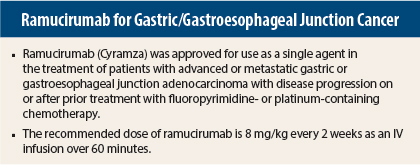On April 21, 2014, ramucirumab (Cyramza) was approved for use as a single agent in the treatment of patients with advanced or metastatic gastric or gastroesophageal junction adenocarcinoma with disease progression on or after prior treatment with fluoropyrimidine- or platinum-containing chemotherapy.1,2
Pivotal Study
Approval was based on the demonstration of improved overall survival in the multinational phase III double-blind REGARD trial, in which 355 patients with previously treated advanced or metastatic gastric or gastroesophageal junction adenocarcinoma were randomly assigned 2:1 to receive intravenous infusion of ramucirumab at 8 mg/kg (n = 238) or placebo (n = 117) every 2 weeks, with both groups also receiving best supportive care.2,3 Patients had disease progression either within 4 months after the last dose of first-line therapy for locally advanced or metastatic disease or within 6 months after the last dose of adjuvant therapy and had to have Eastern Cooperative Oncology Group (ECOG) performance status of 0 or 1.
Patients with bilirubin ≥ 1.5 mg/dL, uncontrolled hypertension, or major surgery within 28 days or who were receiving chronic antiplatelet therapy other than once-daily aspirin were excluded. Randomization was stratified by weight loss over the prior 3 months (≥ 10% vs < 10%), geographic region, and location of the primary tumor (gastric vs gastroesophageal junction).
Baseline characteristics were similar between treatment groups. Overall, median age was 60 years, 70% of patients were men, 77% were white and 16% were Asian, ECOG performance status was 0 for 28% and 1 for 72%, 91% of patients had measurable disease, and 75% had gastric cancer and 25% gastroesophageal junction adenocarcinoma. In total, 85% had disease progression during or following first-line therapy for metastatic disease. Prior chemotherapy consisted of a platinum/fluoropyrimidine combination in 81%, fluoropyrimidine-containing regimens without a platinum agent in 15%, and platinum-containing regimens without a fluoropyrimidine in 4%.
Patients received a median of four doses (range = 1–34) of ramucirumab or a median of three doses (range = 1–30) of placebo. Median overall survival in the ramucirumab group vs the placebo group was 5.2 vs 3.8 months (hazard ratio [HR] = 0.78, P = .047). Median progression-free survival was also prolonged in the ramucirumab group (2.1 vs 1.3 months, HR = 0.48, P < .001).
Recently reported findings of another study (I4T-IE-JVBE) in 665 patients with previously treated advanced or metastatic gastric or gastroesophageal junction adenocarcinoma indicate a survival advantage for the combination of paclitaxel plus ramucirumab vs paclitaxel plus placebo.
How It Works
Ramucirumab is a recombinant human IgG1 monoclonal antibody that acts as a vascular endothelial growth factor receptor 2 (VEGFR2) antagonist. It specifically binds VEGFR2 and blocks binding of the VEGFR ligands VEGF-A, VEGF-C, and VEGF-D. As a result of receptor blockade, ramucirumab inhibits ligand-stimulated activation of VEGFR2, thus inhibiting ligand-induced proliferation and migration of endothelial cells. Ramucirumab was shown to inhibit angiogenesis in animal models.
How It Is Given
The recommended dose of ramucirumab is 8 mg/kg every 2 weeks as an IV infusion over 60 minutes, with treatment continued until disease progression or unacceptable toxicity. All patients should be premedicated with an intravenous histamine H1 antagonist (eg, diphenhydramine hydrochloride) prior to each infusion. Patients who have experienced a grade 1 or 2 infusion reaction should also be premedicated with dexamethasone (or equivalent) and acetaminophen prior to each infusion.
Dose modifications or interruptions are required for infusion-related reactions, hypertension, proteinuria, and wound-healing complications. Ramucirumab should be permanently discontinued in patients who experience arterial thromboembolic events, gastrointestinal perforation, grade 3 or 4 bleeding, or reversible posterior leukoencephalopathy syndrome.
Safety Profile
The safety of ramucirumab as a single agent has been evaluated in 570 patients, including the 236 patients in study I4T-IE-JVBD. In this study, the most common adverse events of any grade that occurred more frequently in the ramucirumab group were hypertension (16% vs 8% in the placebo group), diarrhea (14% vs 9%), headache (9% vs 3%), and hyponatremia (6% vs 2%). The most common grade 3 or 4 adverse events occurring more frequently in the ramucirumab group were hypertension (8% vs 3%), abdominal pain (6% vs 3%), and hyponatremia (3% vs 1%). The most common serious adverse events in ramucirumab patients were anemia (4%) and intestinal obstruction (2%). Red blood cell transfusions were given to 11% vs 9% of patients.
Other clinically relevant adverse events reported in 1% to 5% of patients receiving ramucirumab were neutropenia (5% vs 1%), epistaxis (5% vs 1%), rash (4% vs 2%), and arterial thromboembolic events (2% vs 0%). On laboratory assessment, proteinuria occurred in 8% vs 2% of patients and resulted in discontinuation of ramucirumab in two patients. Gastrointestinal perforation occurred in 0.8% and infusion-related reactions in 0.4% of ramucirumab patients.
A total of 33 (7%) of 443 patients receiving ramucirumab in clinical trials have tested positive for anti-ramucirumab antibodies on an enzyme-linked immunosorbent assay. However, this figure may not be a reliable indicator of rate of antibody development, since the assay has limitations in the detection of anti-ramucirumab antibodies in the presence of ramucirumab. Neutralizing antibodies were detected in one of the patients testing positive for anti-ramucirumab antibodies.
Ramucirumab carries a boxed warning for hemorrhage, including severe and sometimes fatal hemorrhagic events. It also has warnings/precautions for arterial thromboembolic events (including serious, sometimes fatal events), hypertension, infusion-related reactions, gastrointestinal perforation, impaired wound healing, clinical deterioration in patients with cirrhosis (including new onset or worsening encephalopathy, ascites, or hepatorenal syndrome in patients with Child-Pugh B or C cirrhosis), and reversible posterior leukoencephalopathy syndrome.
Based on its mechanism of action, ramucirumab may cause fetal harm. Blood pressure should be routinely monitored in patients receiving ramucirumab, and treatment should be withheld prior to surgery. ■
References
1. U.S. FDA: Ramucirumab. Available at www.fda.gov/Drugs/InformationOnDrugs/ApprovedDrugs/ucm394260.htm.
2. CYRAMZATM (ramucirumab) injection prescribing information. Eli Lilly, April 2014. Available at www.accessdata.fda.gov/drugsatfda_docs/label/2014/125477lbl.pdf.
3. Fuchs CS, Tomasek J, Yong CJ, et al: Ramucirumab monotherapy for previously treated advanced gastric or gastro-oesophageal junction adenocarcinoma (REGARD). Lancet 383:31-39, 2014.


